CONTEMPORARY ACCOUNTING THEORY.
VerifiedAdded on 2023/03/30
|18
|3550
|62
AI Summary
Contribute Materials
Your contribution can guide someone’s learning journey. Share your
documents today.
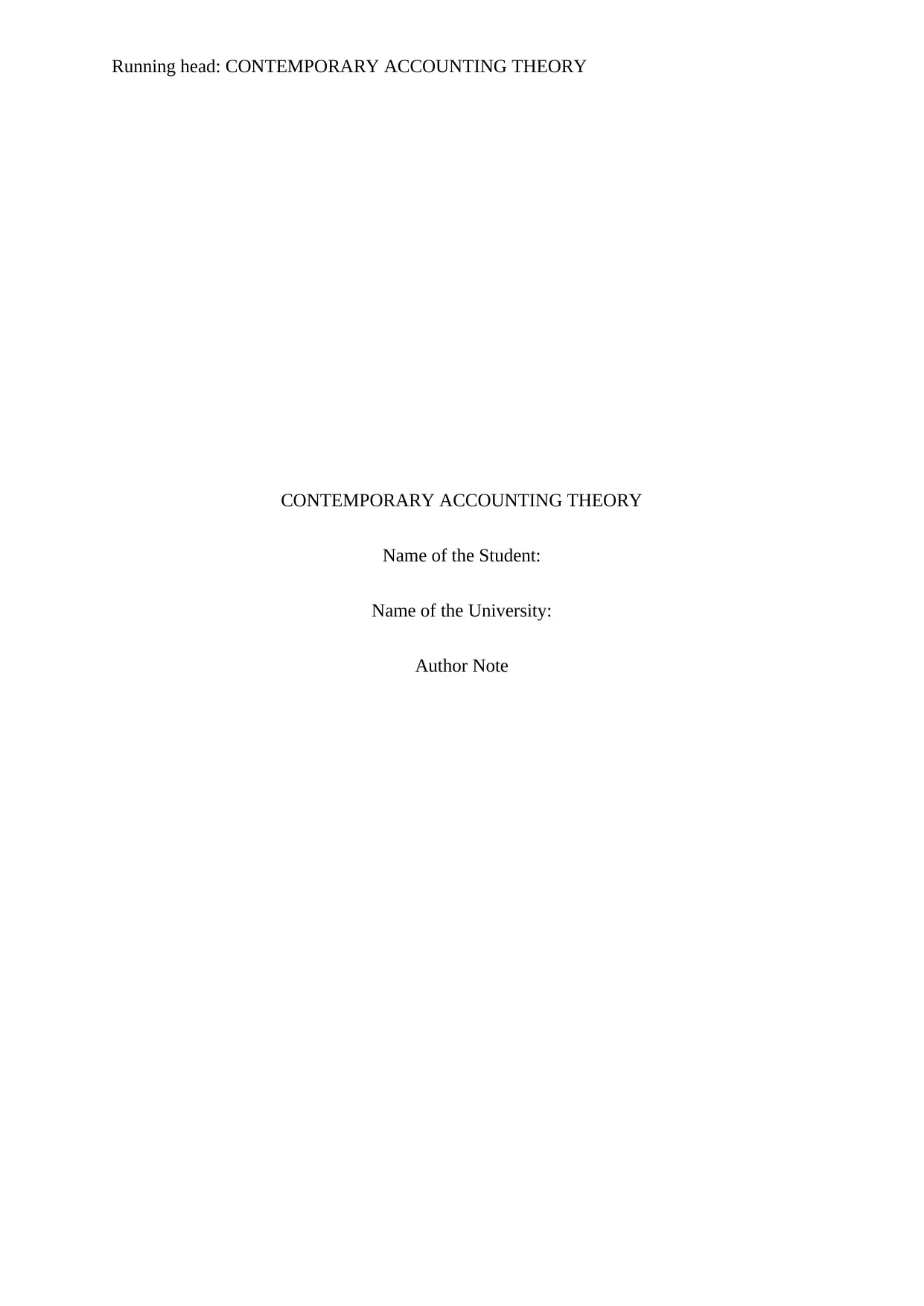
Running head: CONTEMPORARY ACCOUNTING THEORY
CONTEMPORARY ACCOUNTING THEORY
Name of the Student:
Name of the University:
Author Note
CONTEMPORARY ACCOUNTING THEORY
Name of the Student:
Name of the University:
Author Note
Secure Best Marks with AI Grader
Need help grading? Try our AI Grader for instant feedback on your assignments.
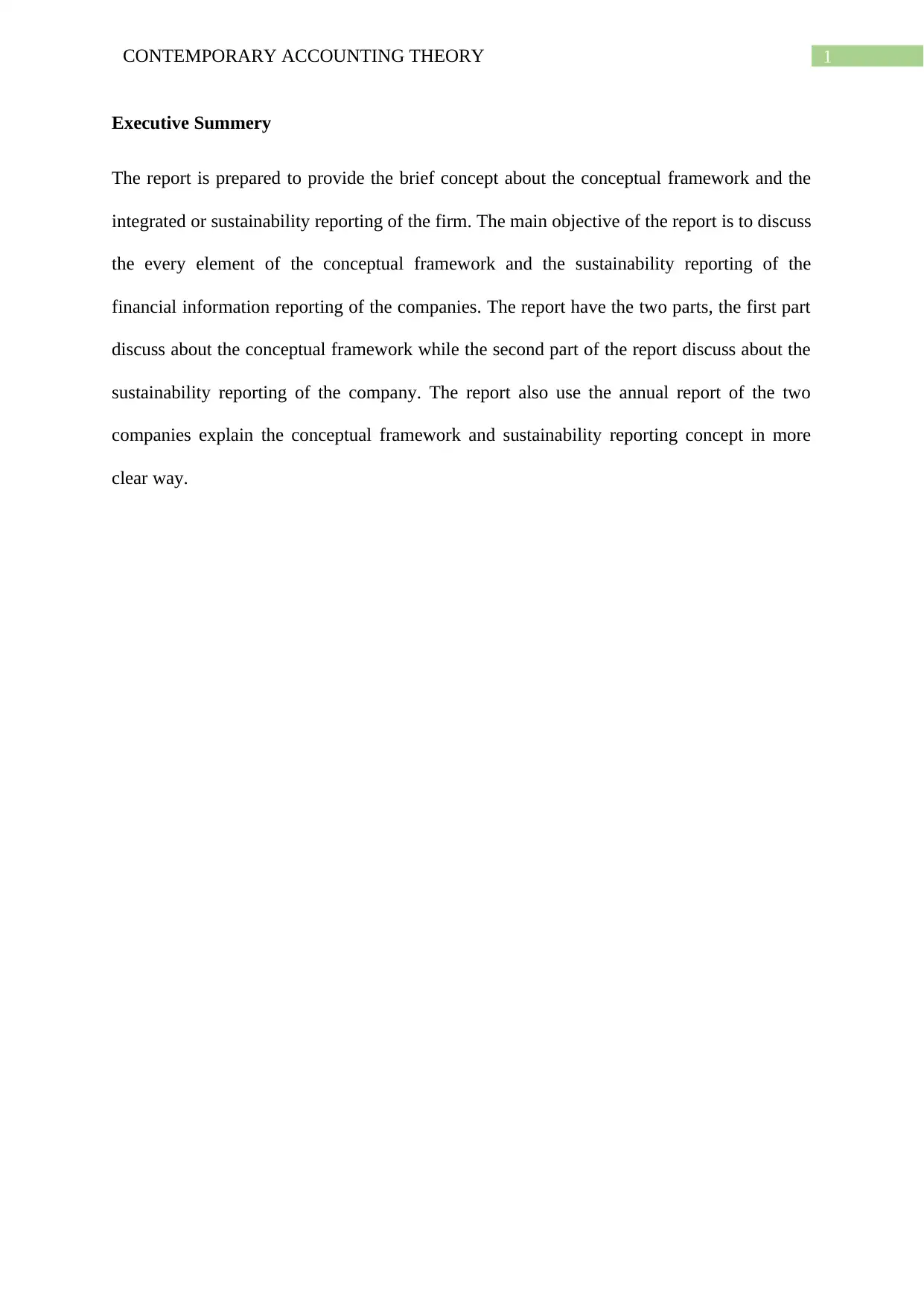
1CONTEMPORARY ACCOUNTING THEORY
Executive Summery
The report is prepared to provide the brief concept about the conceptual framework and the
integrated or sustainability reporting of the firm. The main objective of the report is to discuss
the every element of the conceptual framework and the sustainability reporting of the
financial information reporting of the companies. The report have the two parts, the first part
discuss about the conceptual framework while the second part of the report discuss about the
sustainability reporting of the company. The report also use the annual report of the two
companies explain the conceptual framework and sustainability reporting concept in more
clear way.
Executive Summery
The report is prepared to provide the brief concept about the conceptual framework and the
integrated or sustainability reporting of the firm. The main objective of the report is to discuss
the every element of the conceptual framework and the sustainability reporting of the
financial information reporting of the companies. The report have the two parts, the first part
discuss about the conceptual framework while the second part of the report discuss about the
sustainability reporting of the company. The report also use the annual report of the two
companies explain the conceptual framework and sustainability reporting concept in more
clear way.
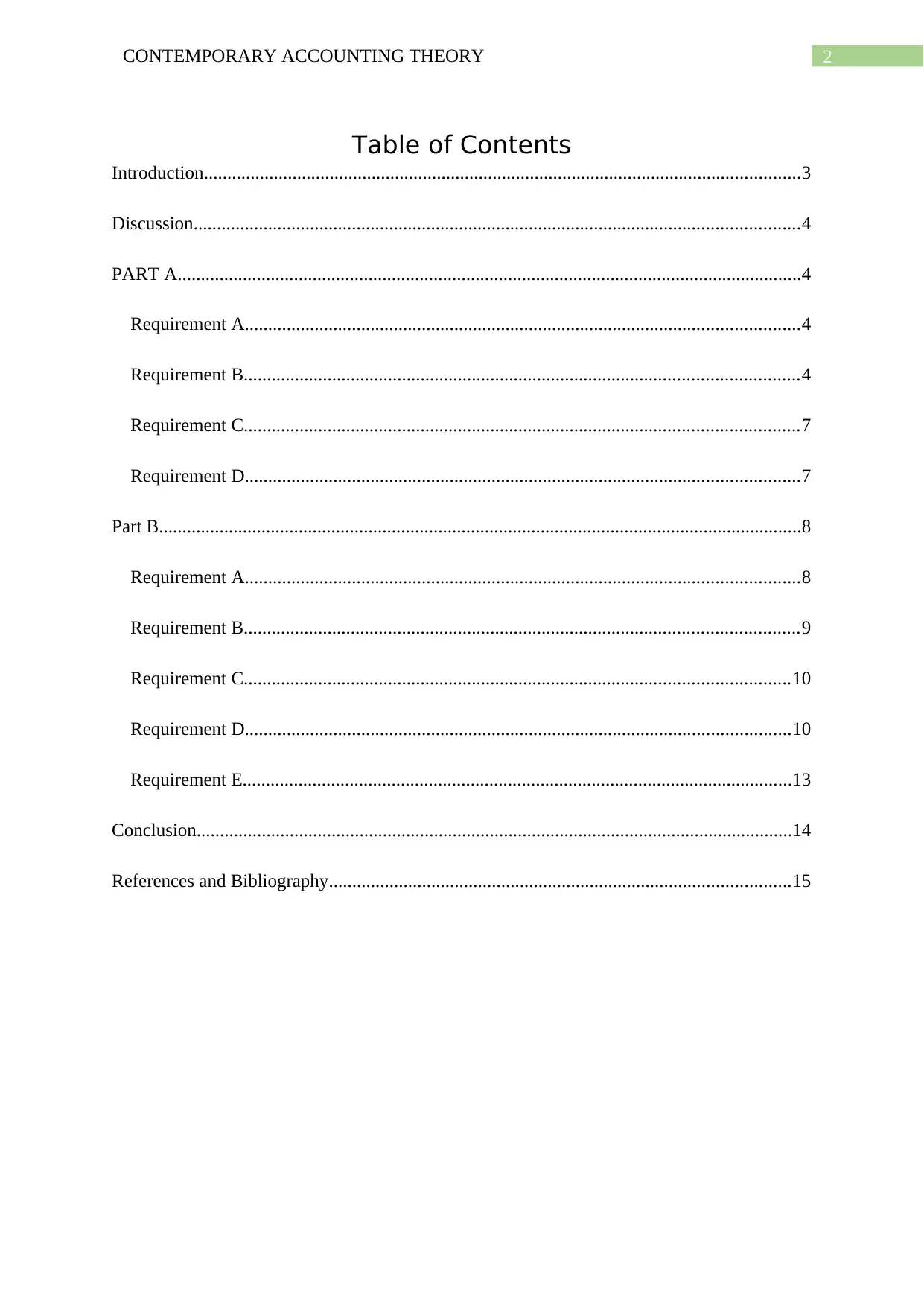
2CONTEMPORARY ACCOUNTING THEORY
Table of Contents
Introduction................................................................................................................................3
Discussion..................................................................................................................................4
PART A......................................................................................................................................4
Requirement A.......................................................................................................................4
Requirement B.......................................................................................................................4
Requirement C.......................................................................................................................7
Requirement D.......................................................................................................................7
Part B..........................................................................................................................................8
Requirement A.......................................................................................................................8
Requirement B.......................................................................................................................9
Requirement C.....................................................................................................................10
Requirement D.....................................................................................................................10
Requirement E......................................................................................................................13
Conclusion................................................................................................................................14
References and Bibliography...................................................................................................15
Table of Contents
Introduction................................................................................................................................3
Discussion..................................................................................................................................4
PART A......................................................................................................................................4
Requirement A.......................................................................................................................4
Requirement B.......................................................................................................................4
Requirement C.......................................................................................................................7
Requirement D.......................................................................................................................7
Part B..........................................................................................................................................8
Requirement A.......................................................................................................................8
Requirement B.......................................................................................................................9
Requirement C.....................................................................................................................10
Requirement D.....................................................................................................................10
Requirement E......................................................................................................................13
Conclusion................................................................................................................................14
References and Bibliography...................................................................................................15
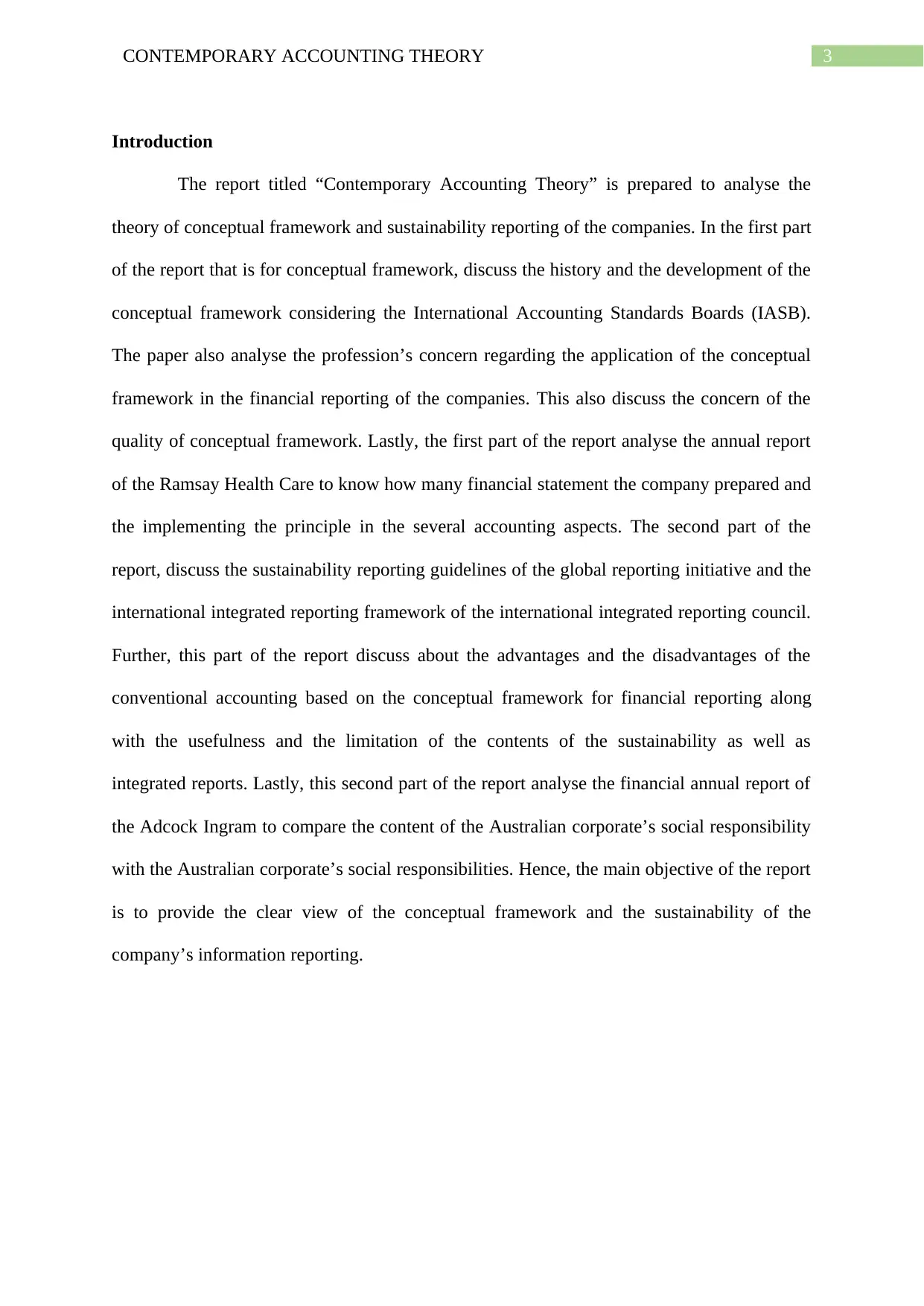
3CONTEMPORARY ACCOUNTING THEORY
Introduction
The report titled “Contemporary Accounting Theory” is prepared to analyse the
theory of conceptual framework and sustainability reporting of the companies. In the first part
of the report that is for conceptual framework, discuss the history and the development of the
conceptual framework considering the International Accounting Standards Boards (IASB).
The paper also analyse the profession’s concern regarding the application of the conceptual
framework in the financial reporting of the companies. This also discuss the concern of the
quality of conceptual framework. Lastly, the first part of the report analyse the annual report
of the Ramsay Health Care to know how many financial statement the company prepared and
the implementing the principle in the several accounting aspects. The second part of the
report, discuss the sustainability reporting guidelines of the global reporting initiative and the
international integrated reporting framework of the international integrated reporting council.
Further, this part of the report discuss about the advantages and the disadvantages of the
conventional accounting based on the conceptual framework for financial reporting along
with the usefulness and the limitation of the contents of the sustainability as well as
integrated reports. Lastly, this second part of the report analyse the financial annual report of
the Adcock Ingram to compare the content of the Australian corporate’s social responsibility
with the Australian corporate’s social responsibilities. Hence, the main objective of the report
is to provide the clear view of the conceptual framework and the sustainability of the
company’s information reporting.
Introduction
The report titled “Contemporary Accounting Theory” is prepared to analyse the
theory of conceptual framework and sustainability reporting of the companies. In the first part
of the report that is for conceptual framework, discuss the history and the development of the
conceptual framework considering the International Accounting Standards Boards (IASB).
The paper also analyse the profession’s concern regarding the application of the conceptual
framework in the financial reporting of the companies. This also discuss the concern of the
quality of conceptual framework. Lastly, the first part of the report analyse the annual report
of the Ramsay Health Care to know how many financial statement the company prepared and
the implementing the principle in the several accounting aspects. The second part of the
report, discuss the sustainability reporting guidelines of the global reporting initiative and the
international integrated reporting framework of the international integrated reporting council.
Further, this part of the report discuss about the advantages and the disadvantages of the
conventional accounting based on the conceptual framework for financial reporting along
with the usefulness and the limitation of the contents of the sustainability as well as
integrated reports. Lastly, this second part of the report analyse the financial annual report of
the Adcock Ingram to compare the content of the Australian corporate’s social responsibility
with the Australian corporate’s social responsibilities. Hence, the main objective of the report
is to provide the clear view of the conceptual framework and the sustainability of the
company’s information reporting.
Secure Best Marks with AI Grader
Need help grading? Try our AI Grader for instant feedback on your assignments.
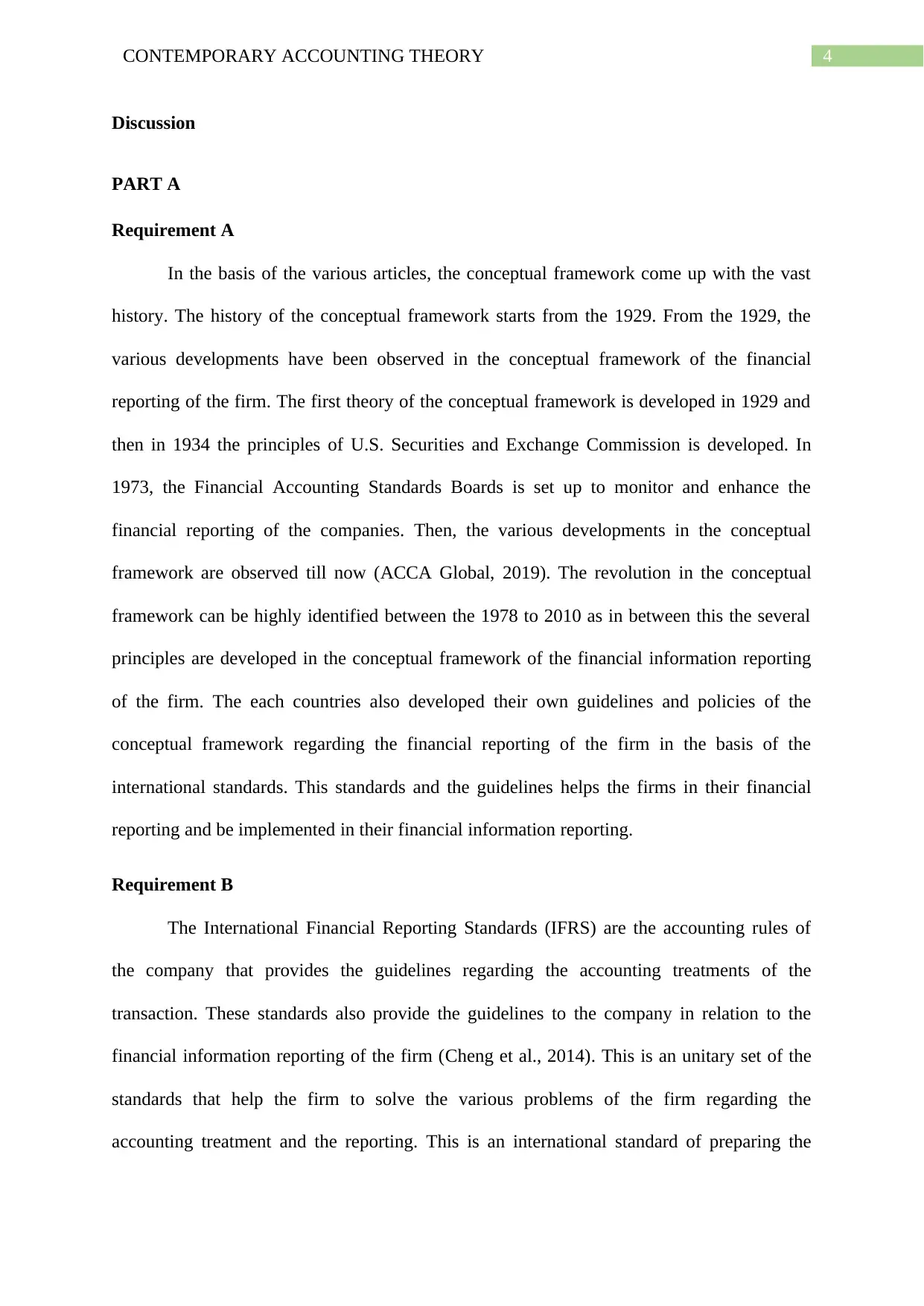
4CONTEMPORARY ACCOUNTING THEORY
Discussion
PART A
Requirement A
In the basis of the various articles, the conceptual framework come up with the vast
history. The history of the conceptual framework starts from the 1929. From the 1929, the
various developments have been observed in the conceptual framework of the financial
reporting of the firm. The first theory of the conceptual framework is developed in 1929 and
then in 1934 the principles of U.S. Securities and Exchange Commission is developed. In
1973, the Financial Accounting Standards Boards is set up to monitor and enhance the
financial reporting of the companies. Then, the various developments in the conceptual
framework are observed till now (ACCA Global, 2019). The revolution in the conceptual
framework can be highly identified between the 1978 to 2010 as in between this the several
principles are developed in the conceptual framework of the financial information reporting
of the firm. The each countries also developed their own guidelines and policies of the
conceptual framework regarding the financial reporting of the firm in the basis of the
international standards. This standards and the guidelines helps the firms in their financial
reporting and be implemented in their financial information reporting.
Requirement B
The International Financial Reporting Standards (IFRS) are the accounting rules of
the company that provides the guidelines regarding the accounting treatments of the
transaction. These standards also provide the guidelines to the company in relation to the
financial information reporting of the firm (Cheng et al., 2014). This is an unitary set of the
standards that help the firm to solve the various problems of the firm regarding the
accounting treatment and the reporting. This is an international standard of preparing the
Discussion
PART A
Requirement A
In the basis of the various articles, the conceptual framework come up with the vast
history. The history of the conceptual framework starts from the 1929. From the 1929, the
various developments have been observed in the conceptual framework of the financial
reporting of the firm. The first theory of the conceptual framework is developed in 1929 and
then in 1934 the principles of U.S. Securities and Exchange Commission is developed. In
1973, the Financial Accounting Standards Boards is set up to monitor and enhance the
financial reporting of the companies. Then, the various developments in the conceptual
framework are observed till now (ACCA Global, 2019). The revolution in the conceptual
framework can be highly identified between the 1978 to 2010 as in between this the several
principles are developed in the conceptual framework of the financial information reporting
of the firm. The each countries also developed their own guidelines and policies of the
conceptual framework regarding the financial reporting of the firm in the basis of the
international standards. This standards and the guidelines helps the firms in their financial
reporting and be implemented in their financial information reporting.
Requirement B
The International Financial Reporting Standards (IFRS) are the accounting rules of
the company that provides the guidelines regarding the accounting treatments of the
transaction. These standards also provide the guidelines to the company in relation to the
financial information reporting of the firm (Cheng et al., 2014). This is an unitary set of the
standards that help the firm to solve the various problems of the firm regarding the
accounting treatment and the reporting. This is an international standard of preparing the
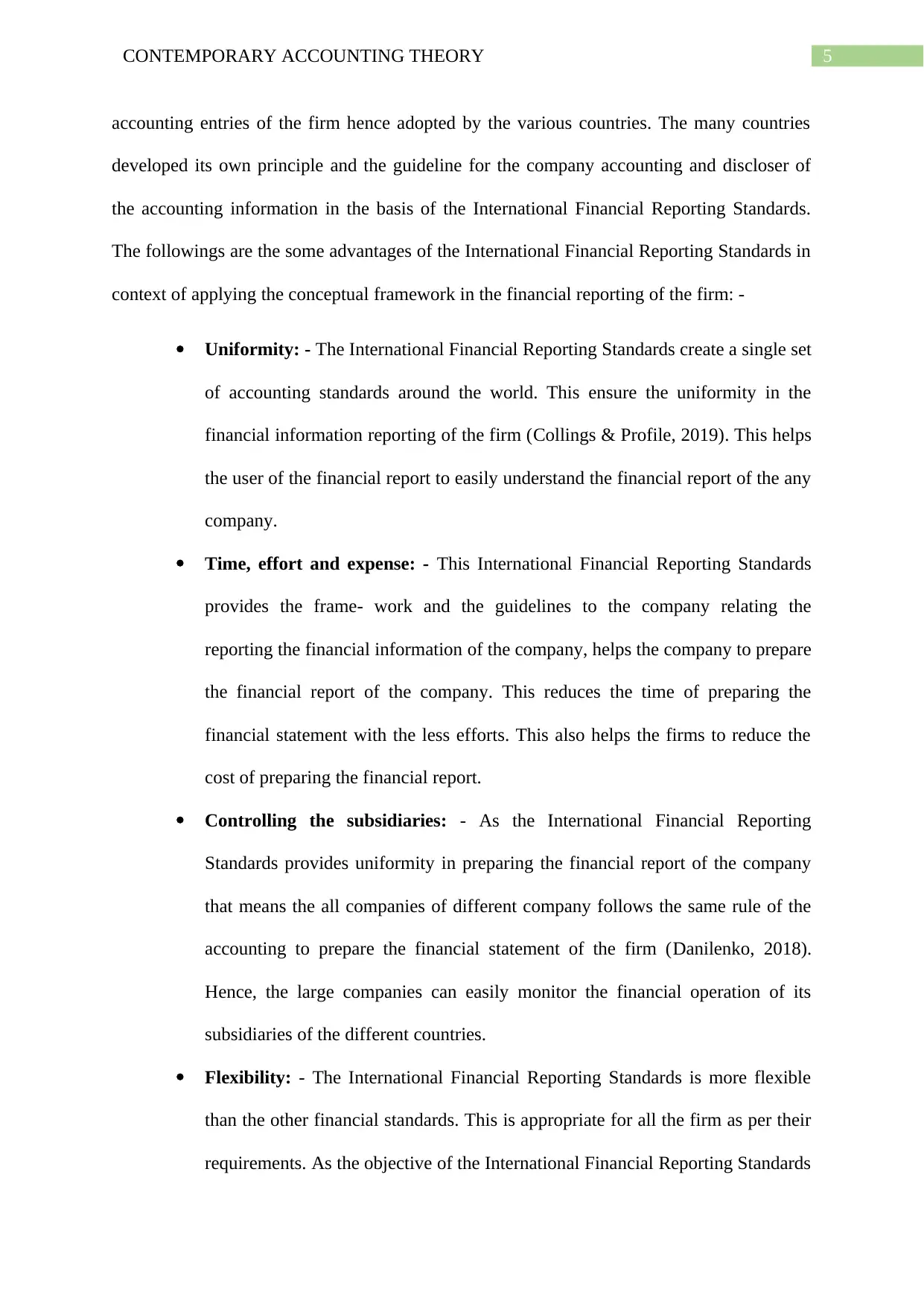
5CONTEMPORARY ACCOUNTING THEORY
accounting entries of the firm hence adopted by the various countries. The many countries
developed its own principle and the guideline for the company accounting and discloser of
the accounting information in the basis of the International Financial Reporting Standards.
The followings are the some advantages of the International Financial Reporting Standards in
context of applying the conceptual framework in the financial reporting of the firm: -
Uniformity: - The International Financial Reporting Standards create a single set
of accounting standards around the world. This ensure the uniformity in the
financial information reporting of the firm (Collings & Profile, 2019). This helps
the user of the financial report to easily understand the financial report of the any
company.
Time, effort and expense: - This International Financial Reporting Standards
provides the frame- work and the guidelines to the company relating the
reporting the financial information of the company, helps the company to prepare
the financial report of the company. This reduces the time of preparing the
financial statement with the less efforts. This also helps the firms to reduce the
cost of preparing the financial report.
Controlling the subsidiaries: - As the International Financial Reporting
Standards provides uniformity in preparing the financial report of the company
that means the all companies of different company follows the same rule of the
accounting to prepare the financial statement of the firm (Danilenko, 2018).
Hence, the large companies can easily monitor the financial operation of its
subsidiaries of the different countries.
Flexibility: - The International Financial Reporting Standards is more flexible
than the other financial standards. This is appropriate for all the firm as per their
requirements. As the objective of the International Financial Reporting Standards
accounting entries of the firm hence adopted by the various countries. The many countries
developed its own principle and the guideline for the company accounting and discloser of
the accounting information in the basis of the International Financial Reporting Standards.
The followings are the some advantages of the International Financial Reporting Standards in
context of applying the conceptual framework in the financial reporting of the firm: -
Uniformity: - The International Financial Reporting Standards create a single set
of accounting standards around the world. This ensure the uniformity in the
financial information reporting of the firm (Collings & Profile, 2019). This helps
the user of the financial report to easily understand the financial report of the any
company.
Time, effort and expense: - This International Financial Reporting Standards
provides the frame- work and the guidelines to the company relating the
reporting the financial information of the company, helps the company to prepare
the financial report of the company. This reduces the time of preparing the
financial statement with the less efforts. This also helps the firms to reduce the
cost of preparing the financial report.
Controlling the subsidiaries: - As the International Financial Reporting
Standards provides uniformity in preparing the financial report of the company
that means the all companies of different company follows the same rule of the
accounting to prepare the financial statement of the firm (Danilenko, 2018).
Hence, the large companies can easily monitor the financial operation of its
subsidiaries of the different countries.
Flexibility: - The International Financial Reporting Standards is more flexible
than the other financial standards. This is appropriate for all the firm as per their
requirements. As the objective of the International Financial Reporting Standards
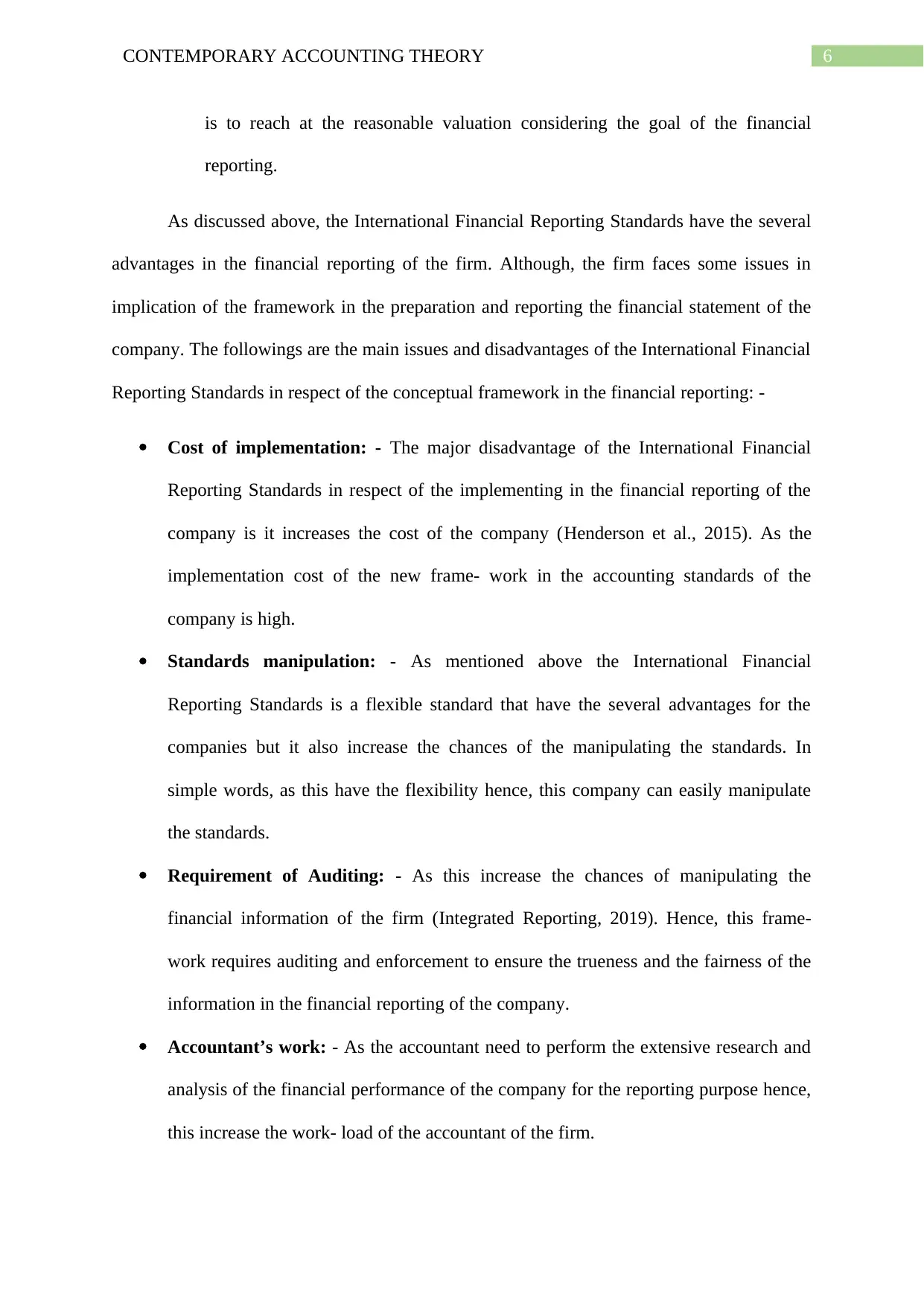
6CONTEMPORARY ACCOUNTING THEORY
is to reach at the reasonable valuation considering the goal of the financial
reporting.
As discussed above, the International Financial Reporting Standards have the several
advantages in the financial reporting of the firm. Although, the firm faces some issues in
implication of the framework in the preparation and reporting the financial statement of the
company. The followings are the main issues and disadvantages of the International Financial
Reporting Standards in respect of the conceptual framework in the financial reporting: -
Cost of implementation: - The major disadvantage of the International Financial
Reporting Standards in respect of the implementing in the financial reporting of the
company is it increases the cost of the company (Henderson et al., 2015). As the
implementation cost of the new frame- work in the accounting standards of the
company is high.
Standards manipulation: - As mentioned above the International Financial
Reporting Standards is a flexible standard that have the several advantages for the
companies but it also increase the chances of the manipulating the standards. In
simple words, as this have the flexibility hence, this company can easily manipulate
the standards.
Requirement of Auditing: - As this increase the chances of manipulating the
financial information of the firm (Integrated Reporting, 2019). Hence, this frame-
work requires auditing and enforcement to ensure the trueness and the fairness of the
information in the financial reporting of the company.
Accountant’s work: - As the accountant need to perform the extensive research and
analysis of the financial performance of the company for the reporting purpose hence,
this increase the work- load of the accountant of the firm.
is to reach at the reasonable valuation considering the goal of the financial
reporting.
As discussed above, the International Financial Reporting Standards have the several
advantages in the financial reporting of the firm. Although, the firm faces some issues in
implication of the framework in the preparation and reporting the financial statement of the
company. The followings are the main issues and disadvantages of the International Financial
Reporting Standards in respect of the conceptual framework in the financial reporting: -
Cost of implementation: - The major disadvantage of the International Financial
Reporting Standards in respect of the implementing in the financial reporting of the
company is it increases the cost of the company (Henderson et al., 2015). As the
implementation cost of the new frame- work in the accounting standards of the
company is high.
Standards manipulation: - As mentioned above the International Financial
Reporting Standards is a flexible standard that have the several advantages for the
companies but it also increase the chances of the manipulating the standards. In
simple words, as this have the flexibility hence, this company can easily manipulate
the standards.
Requirement of Auditing: - As this increase the chances of manipulating the
financial information of the firm (Integrated Reporting, 2019). Hence, this frame-
work requires auditing and enforcement to ensure the trueness and the fairness of the
information in the financial reporting of the company.
Accountant’s work: - As the accountant need to perform the extensive research and
analysis of the financial performance of the company for the reporting purpose hence,
this increase the work- load of the accountant of the firm.
Paraphrase This Document
Need a fresh take? Get an instant paraphrase of this document with our AI Paraphraser
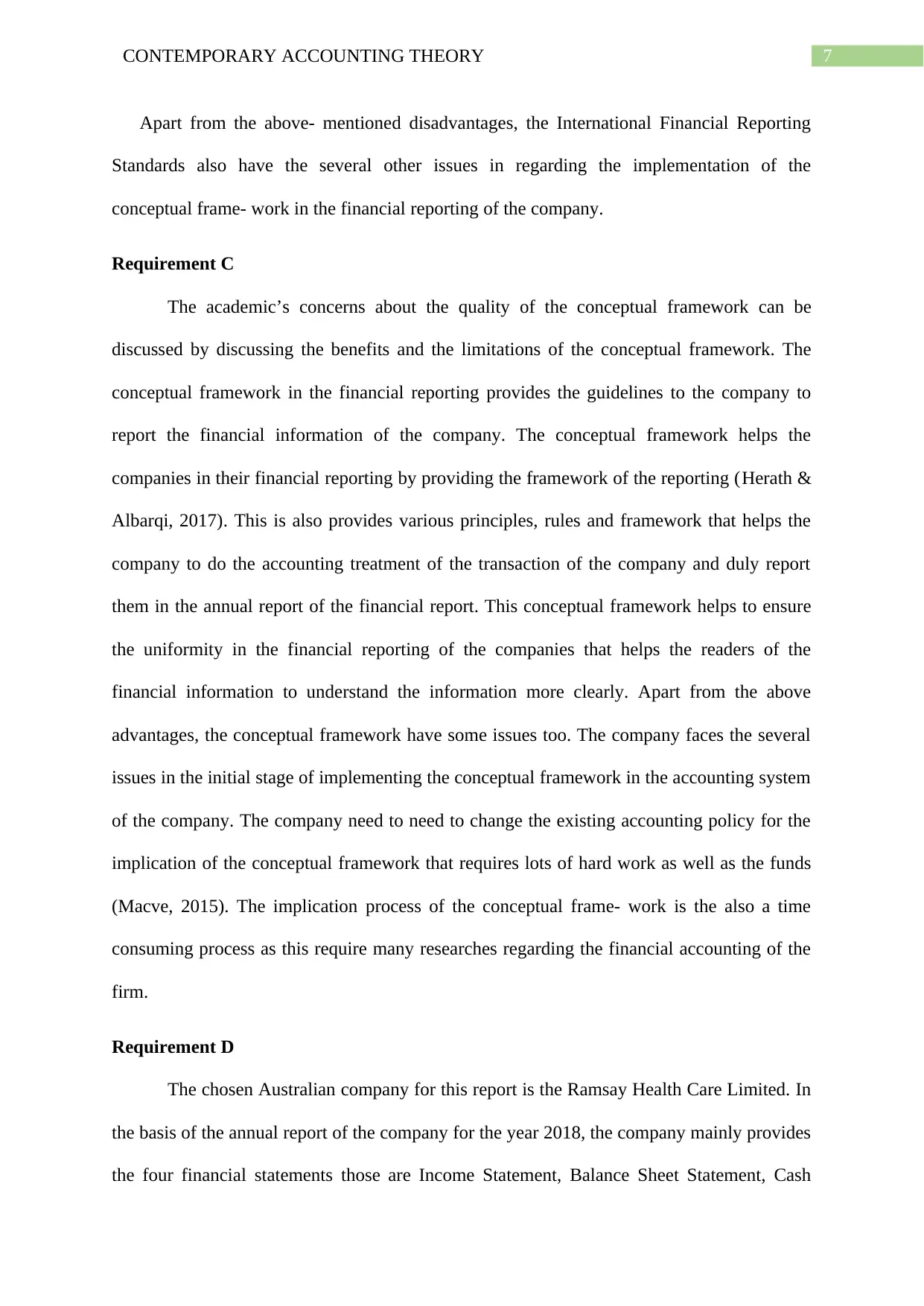
7CONTEMPORARY ACCOUNTING THEORY
Apart from the above- mentioned disadvantages, the International Financial Reporting
Standards also have the several other issues in regarding the implementation of the
conceptual frame- work in the financial reporting of the company.
Requirement C
The academic’s concerns about the quality of the conceptual framework can be
discussed by discussing the benefits and the limitations of the conceptual framework. The
conceptual framework in the financial reporting provides the guidelines to the company to
report the financial information of the company. The conceptual framework helps the
companies in their financial reporting by providing the framework of the reporting (Herath &
Albarqi, 2017). This is also provides various principles, rules and framework that helps the
company to do the accounting treatment of the transaction of the company and duly report
them in the annual report of the financial report. This conceptual framework helps to ensure
the uniformity in the financial reporting of the companies that helps the readers of the
financial information to understand the information more clearly. Apart from the above
advantages, the conceptual framework have some issues too. The company faces the several
issues in the initial stage of implementing the conceptual framework in the accounting system
of the company. The company need to need to change the existing accounting policy for the
implication of the conceptual framework that requires lots of hard work as well as the funds
(Macve, 2015). The implication process of the conceptual frame- work is the also a time
consuming process as this require many researches regarding the financial accounting of the
firm.
Requirement D
The chosen Australian company for this report is the Ramsay Health Care Limited. In
the basis of the annual report of the company for the year 2018, the company mainly provides
the four financial statements those are Income Statement, Balance Sheet Statement, Cash
Apart from the above- mentioned disadvantages, the International Financial Reporting
Standards also have the several other issues in regarding the implementation of the
conceptual frame- work in the financial reporting of the company.
Requirement C
The academic’s concerns about the quality of the conceptual framework can be
discussed by discussing the benefits and the limitations of the conceptual framework. The
conceptual framework in the financial reporting provides the guidelines to the company to
report the financial information of the company. The conceptual framework helps the
companies in their financial reporting by providing the framework of the reporting (Herath &
Albarqi, 2017). This is also provides various principles, rules and framework that helps the
company to do the accounting treatment of the transaction of the company and duly report
them in the annual report of the financial report. This conceptual framework helps to ensure
the uniformity in the financial reporting of the companies that helps the readers of the
financial information to understand the information more clearly. Apart from the above
advantages, the conceptual framework have some issues too. The company faces the several
issues in the initial stage of implementing the conceptual framework in the accounting system
of the company. The company need to need to change the existing accounting policy for the
implication of the conceptual framework that requires lots of hard work as well as the funds
(Macve, 2015). The implication process of the conceptual frame- work is the also a time
consuming process as this require many researches regarding the financial accounting of the
firm.
Requirement D
The chosen Australian company for this report is the Ramsay Health Care Limited. In
the basis of the annual report of the company for the year 2018, the company mainly provides
the four financial statements those are Income Statement, Balance Sheet Statement, Cash
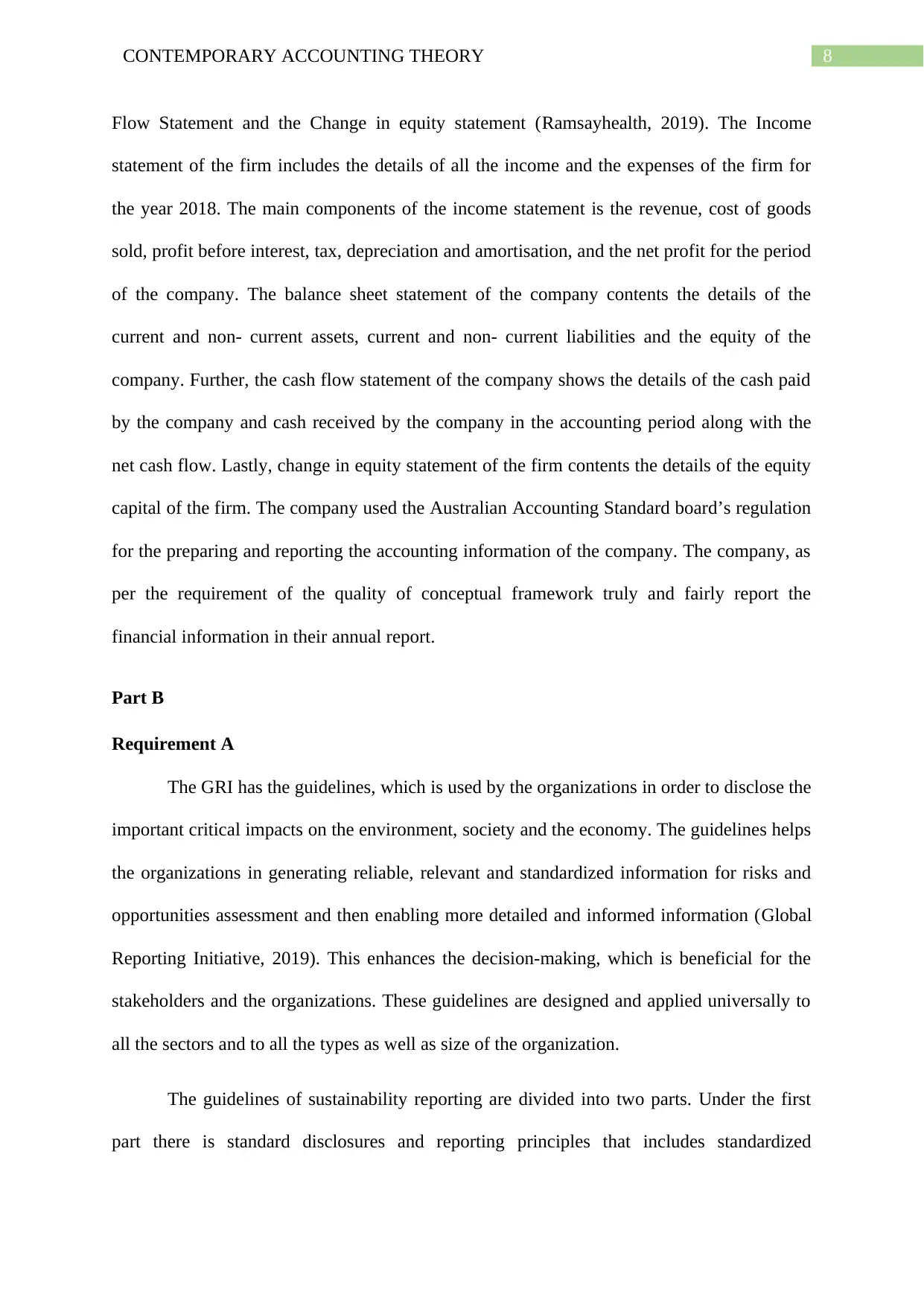
8CONTEMPORARY ACCOUNTING THEORY
Flow Statement and the Change in equity statement (Ramsayhealth, 2019). The Income
statement of the firm includes the details of all the income and the expenses of the firm for
the year 2018. The main components of the income statement is the revenue, cost of goods
sold, profit before interest, tax, depreciation and amortisation, and the net profit for the period
of the company. The balance sheet statement of the company contents the details of the
current and non- current assets, current and non- current liabilities and the equity of the
company. Further, the cash flow statement of the company shows the details of the cash paid
by the company and cash received by the company in the accounting period along with the
net cash flow. Lastly, change in equity statement of the firm contents the details of the equity
capital of the firm. The company used the Australian Accounting Standard board’s regulation
for the preparing and reporting the accounting information of the company. The company, as
per the requirement of the quality of conceptual framework truly and fairly report the
financial information in their annual report.
Part B
Requirement A
The GRI has the guidelines, which is used by the organizations in order to disclose the
important critical impacts on the environment, society and the economy. The guidelines helps
the organizations in generating reliable, relevant and standardized information for risks and
opportunities assessment and then enabling more detailed and informed information (Global
Reporting Initiative, 2019). This enhances the decision-making, which is beneficial for the
stakeholders and the organizations. These guidelines are designed and applied universally to
all the sectors and to all the types as well as size of the organization.
The guidelines of sustainability reporting are divided into two parts. Under the first
part there is standard disclosures and reporting principles that includes standardized
Flow Statement and the Change in equity statement (Ramsayhealth, 2019). The Income
statement of the firm includes the details of all the income and the expenses of the firm for
the year 2018. The main components of the income statement is the revenue, cost of goods
sold, profit before interest, tax, depreciation and amortisation, and the net profit for the period
of the company. The balance sheet statement of the company contents the details of the
current and non- current assets, current and non- current liabilities and the equity of the
company. Further, the cash flow statement of the company shows the details of the cash paid
by the company and cash received by the company in the accounting period along with the
net cash flow. Lastly, change in equity statement of the firm contents the details of the equity
capital of the firm. The company used the Australian Accounting Standard board’s regulation
for the preparing and reporting the accounting information of the company. The company, as
per the requirement of the quality of conceptual framework truly and fairly report the
financial information in their annual report.
Part B
Requirement A
The GRI has the guidelines, which is used by the organizations in order to disclose the
important critical impacts on the environment, society and the economy. The guidelines helps
the organizations in generating reliable, relevant and standardized information for risks and
opportunities assessment and then enabling more detailed and informed information (Global
Reporting Initiative, 2019). This enhances the decision-making, which is beneficial for the
stakeholders and the organizations. These guidelines are designed and applied universally to
all the sectors and to all the types as well as size of the organization.
The guidelines of sustainability reporting are divided into two parts. Under the first
part there is standard disclosures and reporting principles that includes standardized
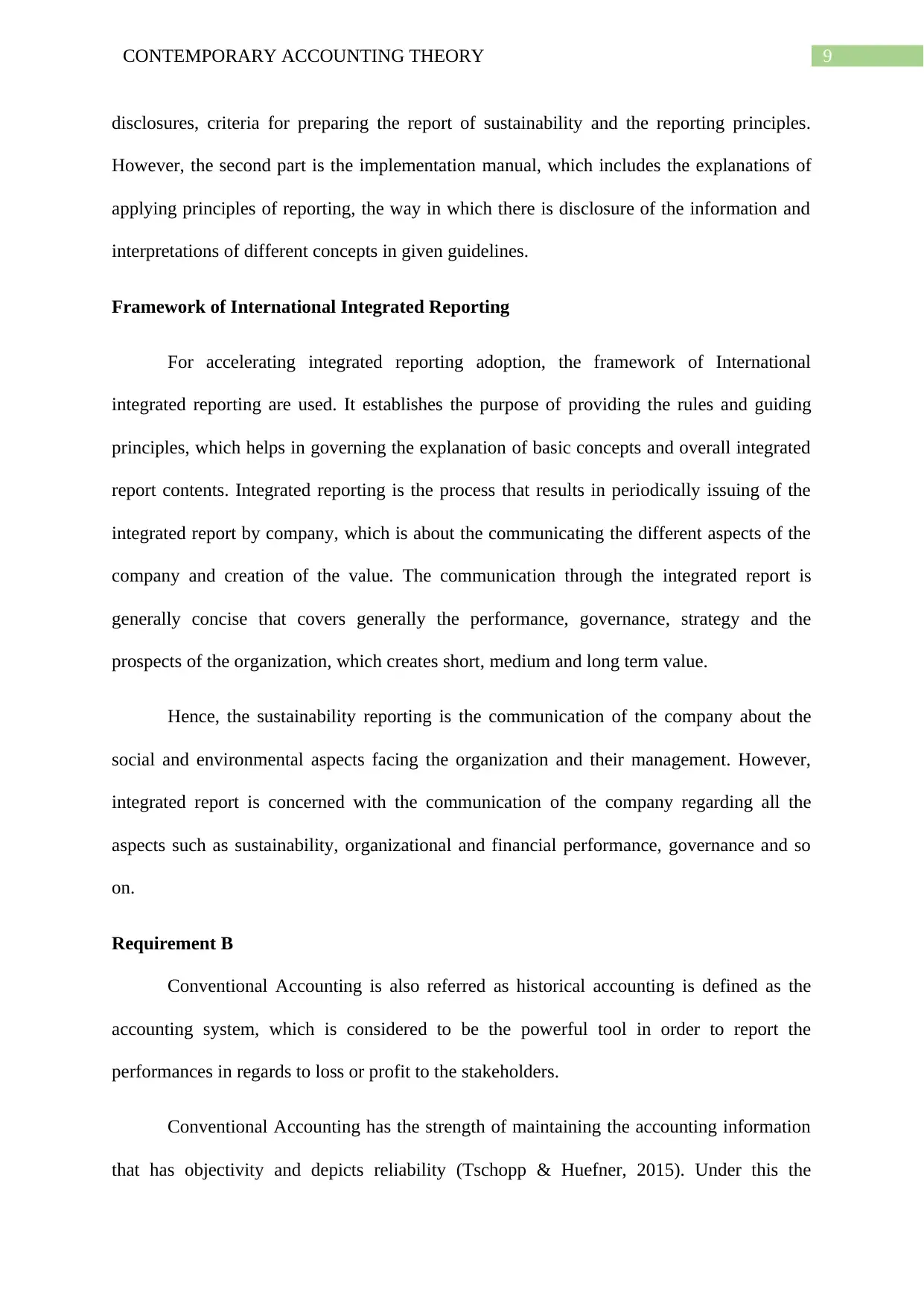
9CONTEMPORARY ACCOUNTING THEORY
disclosures, criteria for preparing the report of sustainability and the reporting principles.
However, the second part is the implementation manual, which includes the explanations of
applying principles of reporting, the way in which there is disclosure of the information and
interpretations of different concepts in given guidelines.
Framework of International Integrated Reporting
For accelerating integrated reporting adoption, the framework of International
integrated reporting are used. It establishes the purpose of providing the rules and guiding
principles, which helps in governing the explanation of basic concepts and overall integrated
report contents. Integrated reporting is the process that results in periodically issuing of the
integrated report by company, which is about the communicating the different aspects of the
company and creation of the value. The communication through the integrated report is
generally concise that covers generally the performance, governance, strategy and the
prospects of the organization, which creates short, medium and long term value.
Hence, the sustainability reporting is the communication of the company about the
social and environmental aspects facing the organization and their management. However,
integrated report is concerned with the communication of the company regarding all the
aspects such as sustainability, organizational and financial performance, governance and so
on.
Requirement B
Conventional Accounting is also referred as historical accounting is defined as the
accounting system, which is considered to be the powerful tool in order to report the
performances in regards to loss or profit to the stakeholders.
Conventional Accounting has the strength of maintaining the accounting information
that has objectivity and depicts reliability (Tschopp & Huefner, 2015). Under this the
disclosures, criteria for preparing the report of sustainability and the reporting principles.
However, the second part is the implementation manual, which includes the explanations of
applying principles of reporting, the way in which there is disclosure of the information and
interpretations of different concepts in given guidelines.
Framework of International Integrated Reporting
For accelerating integrated reporting adoption, the framework of International
integrated reporting are used. It establishes the purpose of providing the rules and guiding
principles, which helps in governing the explanation of basic concepts and overall integrated
report contents. Integrated reporting is the process that results in periodically issuing of the
integrated report by company, which is about the communicating the different aspects of the
company and creation of the value. The communication through the integrated report is
generally concise that covers generally the performance, governance, strategy and the
prospects of the organization, which creates short, medium and long term value.
Hence, the sustainability reporting is the communication of the company about the
social and environmental aspects facing the organization and their management. However,
integrated report is concerned with the communication of the company regarding all the
aspects such as sustainability, organizational and financial performance, governance and so
on.
Requirement B
Conventional Accounting is also referred as historical accounting is defined as the
accounting system, which is considered to be the powerful tool in order to report the
performances in regards to loss or profit to the stakeholders.
Conventional Accounting has the strength of maintaining the accounting information
that has objectivity and depicts reliability (Tschopp & Huefner, 2015). Under this the
Secure Best Marks with AI Grader
Need help grading? Try our AI Grader for instant feedback on your assignments.
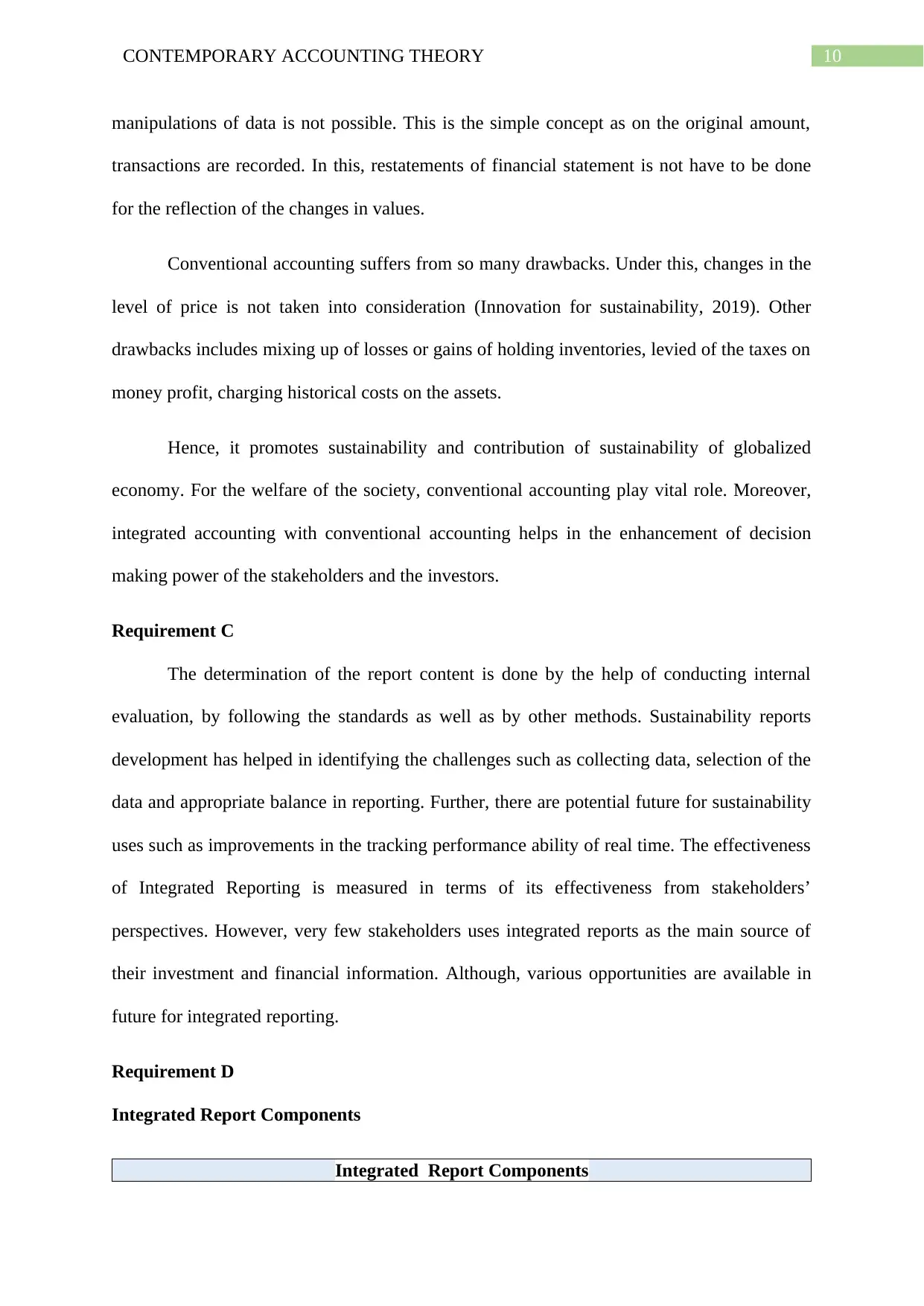
10CONTEMPORARY ACCOUNTING THEORY
manipulations of data is not possible. This is the simple concept as on the original amount,
transactions are recorded. In this, restatements of financial statement is not have to be done
for the reflection of the changes in values.
Conventional accounting suffers from so many drawbacks. Under this, changes in the
level of price is not taken into consideration (Innovation for sustainability, 2019). Other
drawbacks includes mixing up of losses or gains of holding inventories, levied of the taxes on
money profit, charging historical costs on the assets.
Hence, it promotes sustainability and contribution of sustainability of globalized
economy. For the welfare of the society, conventional accounting play vital role. Moreover,
integrated accounting with conventional accounting helps in the enhancement of decision
making power of the stakeholders and the investors.
Requirement C
The determination of the report content is done by the help of conducting internal
evaluation, by following the standards as well as by other methods. Sustainability reports
development has helped in identifying the challenges such as collecting data, selection of the
data and appropriate balance in reporting. Further, there are potential future for sustainability
uses such as improvements in the tracking performance ability of real time. The effectiveness
of Integrated Reporting is measured in terms of its effectiveness from stakeholders’
perspectives. However, very few stakeholders uses integrated reports as the main source of
their investment and financial information. Although, various opportunities are available in
future for integrated reporting.
Requirement D
Integrated Report Components
Integrated Report Components
manipulations of data is not possible. This is the simple concept as on the original amount,
transactions are recorded. In this, restatements of financial statement is not have to be done
for the reflection of the changes in values.
Conventional accounting suffers from so many drawbacks. Under this, changes in the
level of price is not taken into consideration (Innovation for sustainability, 2019). Other
drawbacks includes mixing up of losses or gains of holding inventories, levied of the taxes on
money profit, charging historical costs on the assets.
Hence, it promotes sustainability and contribution of sustainability of globalized
economy. For the welfare of the society, conventional accounting play vital role. Moreover,
integrated accounting with conventional accounting helps in the enhancement of decision
making power of the stakeholders and the investors.
Requirement C
The determination of the report content is done by the help of conducting internal
evaluation, by following the standards as well as by other methods. Sustainability reports
development has helped in identifying the challenges such as collecting data, selection of the
data and appropriate balance in reporting. Further, there are potential future for sustainability
uses such as improvements in the tracking performance ability of real time. The effectiveness
of Integrated Reporting is measured in terms of its effectiveness from stakeholders’
perspectives. However, very few stakeholders uses integrated reports as the main source of
their investment and financial information. Although, various opportunities are available in
future for integrated reporting.
Requirement D
Integrated Report Components
Integrated Report Components
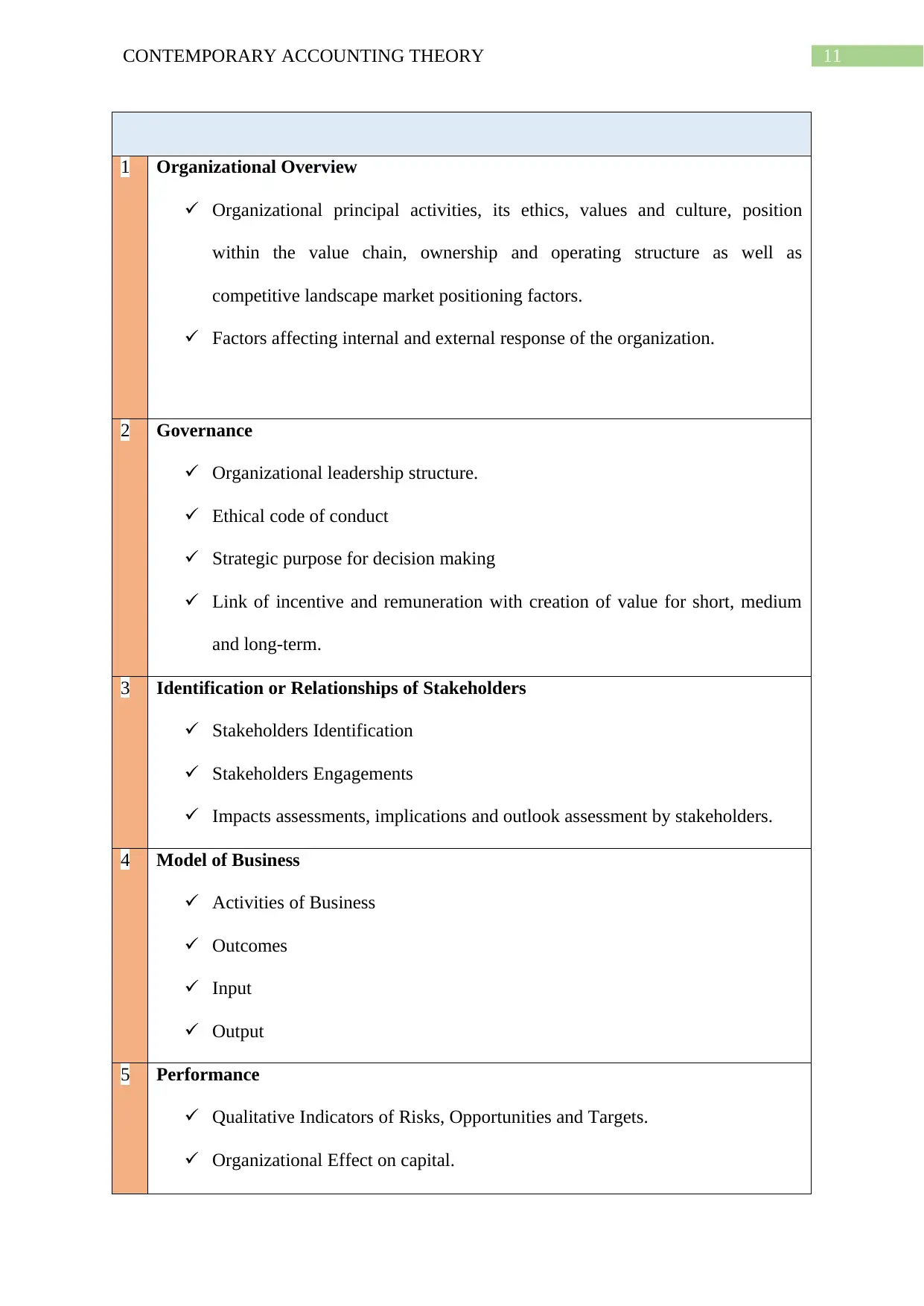
11CONTEMPORARY ACCOUNTING THEORY
1 Organizational Overview
Organizational principal activities, its ethics, values and culture, position
within the value chain, ownership and operating structure as well as
competitive landscape market positioning factors.
Factors affecting internal and external response of the organization.
2 Governance
Organizational leadership structure.
Ethical code of conduct
Strategic purpose for decision making
Link of incentive and remuneration with creation of value for short, medium
and long-term.
3 Identification or Relationships of Stakeholders
Stakeholders Identification
Stakeholders Engagements
Impacts assessments, implications and outlook assessment by stakeholders.
4 Model of Business
Activities of Business
Outcomes
Input
Output
5 Performance
Qualitative Indicators of Risks, Opportunities and Targets.
Organizational Effect on capital.
1 Organizational Overview
Organizational principal activities, its ethics, values and culture, position
within the value chain, ownership and operating structure as well as
competitive landscape market positioning factors.
Factors affecting internal and external response of the organization.
2 Governance
Organizational leadership structure.
Ethical code of conduct
Strategic purpose for decision making
Link of incentive and remuneration with creation of value for short, medium
and long-term.
3 Identification or Relationships of Stakeholders
Stakeholders Identification
Stakeholders Engagements
Impacts assessments, implications and outlook assessment by stakeholders.
4 Model of Business
Activities of Business
Outcomes
Input
Output
5 Performance
Qualitative Indicators of Risks, Opportunities and Targets.
Organizational Effect on capital.
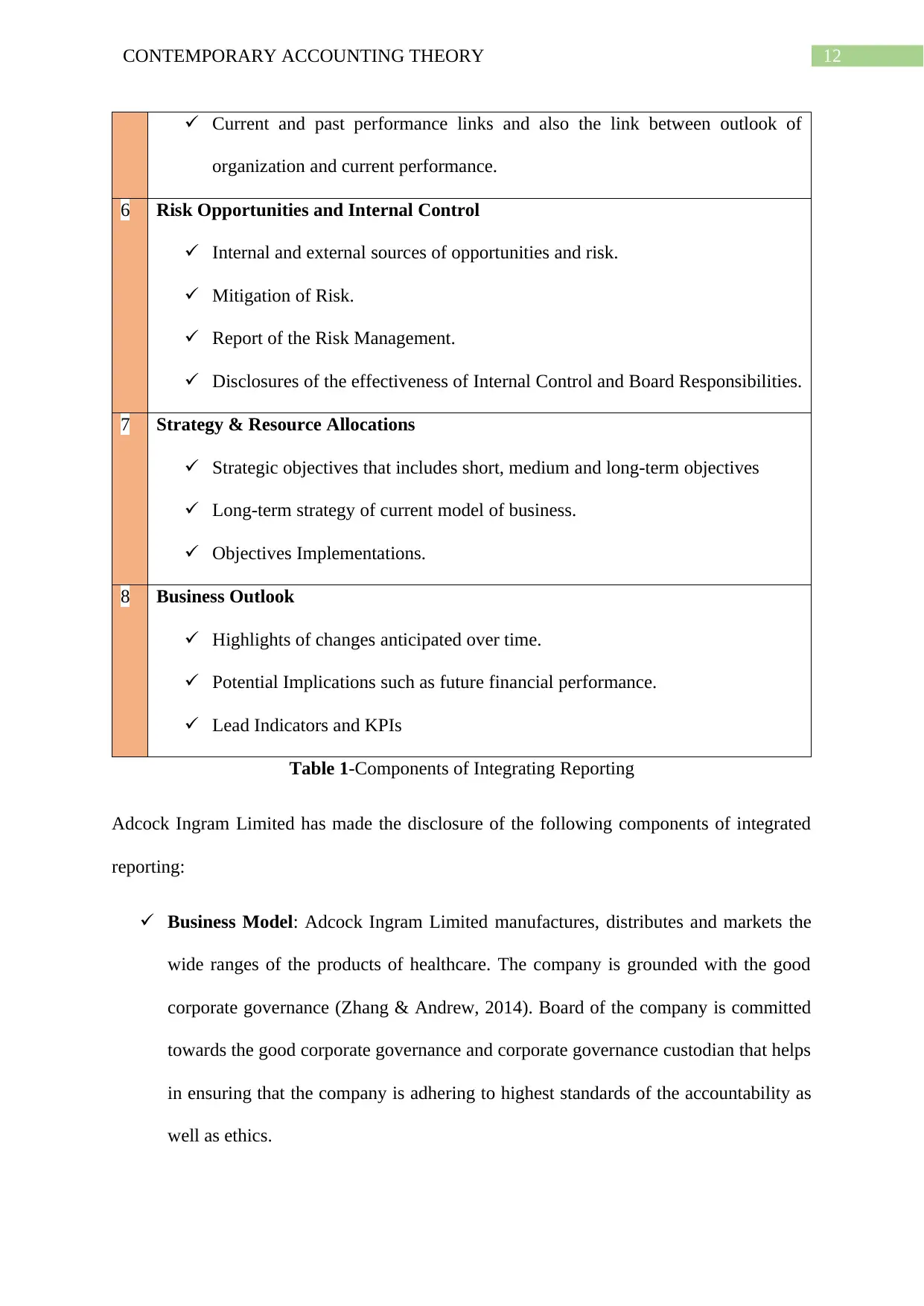
12CONTEMPORARY ACCOUNTING THEORY
Current and past performance links and also the link between outlook of
organization and current performance.
6 Risk Opportunities and Internal Control
Internal and external sources of opportunities and risk.
Mitigation of Risk.
Report of the Risk Management.
Disclosures of the effectiveness of Internal Control and Board Responsibilities.
7 Strategy & Resource Allocations
Strategic objectives that includes short, medium and long-term objectives
Long-term strategy of current model of business.
Objectives Implementations.
8 Business Outlook
Highlights of changes anticipated over time.
Potential Implications such as future financial performance.
Lead Indicators and KPIs
Table 1-Components of Integrating Reporting
Adcock Ingram Limited has made the disclosure of the following components of integrated
reporting:
Business Model: Adcock Ingram Limited manufactures, distributes and markets the
wide ranges of the products of healthcare. The company is grounded with the good
corporate governance (Zhang & Andrew, 2014). Board of the company is committed
towards the good corporate governance and corporate governance custodian that helps
in ensuring that the company is adhering to highest standards of the accountability as
well as ethics.
Current and past performance links and also the link between outlook of
organization and current performance.
6 Risk Opportunities and Internal Control
Internal and external sources of opportunities and risk.
Mitigation of Risk.
Report of the Risk Management.
Disclosures of the effectiveness of Internal Control and Board Responsibilities.
7 Strategy & Resource Allocations
Strategic objectives that includes short, medium and long-term objectives
Long-term strategy of current model of business.
Objectives Implementations.
8 Business Outlook
Highlights of changes anticipated over time.
Potential Implications such as future financial performance.
Lead Indicators and KPIs
Table 1-Components of Integrating Reporting
Adcock Ingram Limited has made the disclosure of the following components of integrated
reporting:
Business Model: Adcock Ingram Limited manufactures, distributes and markets the
wide ranges of the products of healthcare. The company is grounded with the good
corporate governance (Zhang & Andrew, 2014). Board of the company is committed
towards the good corporate governance and corporate governance custodian that helps
in ensuring that the company is adhering to highest standards of the accountability as
well as ethics.
Paraphrase This Document
Need a fresh take? Get an instant paraphrase of this document with our AI Paraphraser
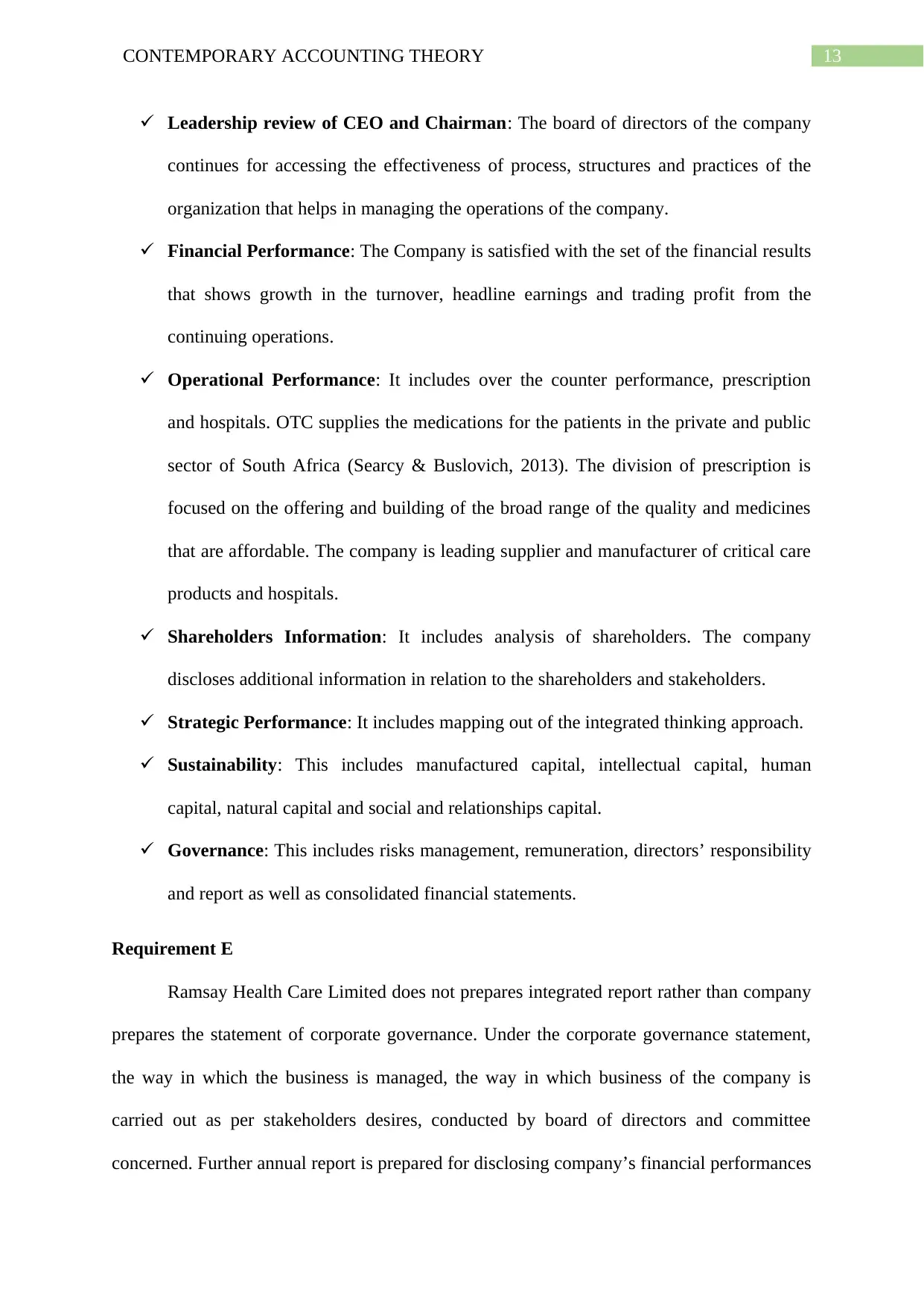
13CONTEMPORARY ACCOUNTING THEORY
Leadership review of CEO and Chairman: The board of directors of the company
continues for accessing the effectiveness of process, structures and practices of the
organization that helps in managing the operations of the company.
Financial Performance: The Company is satisfied with the set of the financial results
that shows growth in the turnover, headline earnings and trading profit from the
continuing operations.
Operational Performance: It includes over the counter performance, prescription
and hospitals. OTC supplies the medications for the patients in the private and public
sector of South Africa (Searcy & Buslovich, 2013). The division of prescription is
focused on the offering and building of the broad range of the quality and medicines
that are affordable. The company is leading supplier and manufacturer of critical care
products and hospitals.
Shareholders Information: It includes analysis of shareholders. The company
discloses additional information in relation to the shareholders and stakeholders.
Strategic Performance: It includes mapping out of the integrated thinking approach.
Sustainability: This includes manufactured capital, intellectual capital, human
capital, natural capital and social and relationships capital.
Governance: This includes risks management, remuneration, directors’ responsibility
and report as well as consolidated financial statements.
Requirement E
Ramsay Health Care Limited does not prepares integrated report rather than company
prepares the statement of corporate governance. Under the corporate governance statement,
the way in which the business is managed, the way in which business of the company is
carried out as per stakeholders desires, conducted by board of directors and committee
concerned. Further annual report is prepared for disclosing company’s financial performances
Leadership review of CEO and Chairman: The board of directors of the company
continues for accessing the effectiveness of process, structures and practices of the
organization that helps in managing the operations of the company.
Financial Performance: The Company is satisfied with the set of the financial results
that shows growth in the turnover, headline earnings and trading profit from the
continuing operations.
Operational Performance: It includes over the counter performance, prescription
and hospitals. OTC supplies the medications for the patients in the private and public
sector of South Africa (Searcy & Buslovich, 2013). The division of prescription is
focused on the offering and building of the broad range of the quality and medicines
that are affordable. The company is leading supplier and manufacturer of critical care
products and hospitals.
Shareholders Information: It includes analysis of shareholders. The company
discloses additional information in relation to the shareholders and stakeholders.
Strategic Performance: It includes mapping out of the integrated thinking approach.
Sustainability: This includes manufactured capital, intellectual capital, human
capital, natural capital and social and relationships capital.
Governance: This includes risks management, remuneration, directors’ responsibility
and report as well as consolidated financial statements.
Requirement E
Ramsay Health Care Limited does not prepares integrated report rather than company
prepares the statement of corporate governance. Under the corporate governance statement,
the way in which the business is managed, the way in which business of the company is
carried out as per stakeholders desires, conducted by board of directors and committee
concerned. Further annual report is prepared for disclosing company’s financial performances
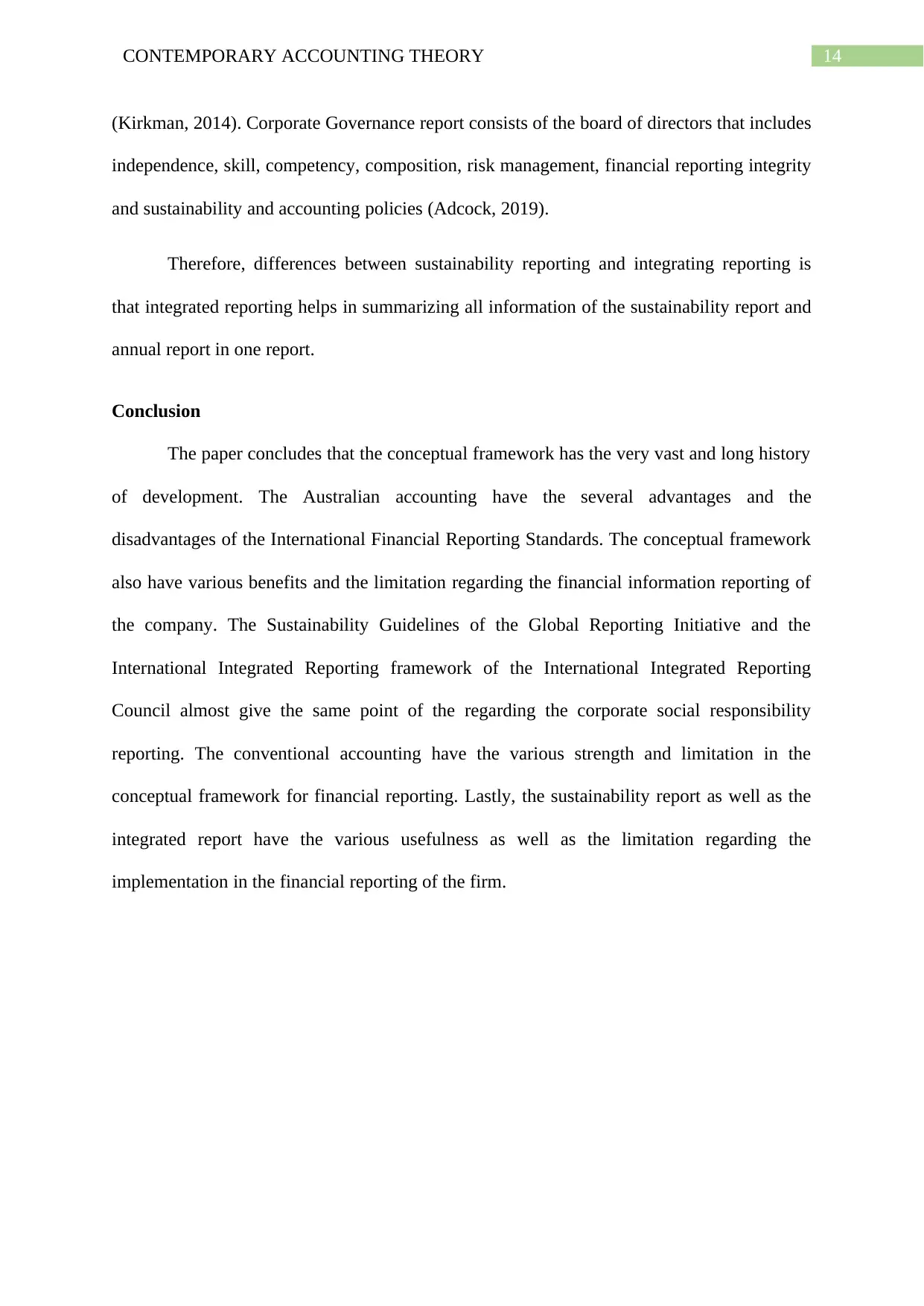
14CONTEMPORARY ACCOUNTING THEORY
(Kirkman, 2014). Corporate Governance report consists of the board of directors that includes
independence, skill, competency, composition, risk management, financial reporting integrity
and sustainability and accounting policies (Adcock, 2019).
Therefore, differences between sustainability reporting and integrating reporting is
that integrated reporting helps in summarizing all information of the sustainability report and
annual report in one report.
Conclusion
The paper concludes that the conceptual framework has the very vast and long history
of development. The Australian accounting have the several advantages and the
disadvantages of the International Financial Reporting Standards. The conceptual framework
also have various benefits and the limitation regarding the financial information reporting of
the company. The Sustainability Guidelines of the Global Reporting Initiative and the
International Integrated Reporting framework of the International Integrated Reporting
Council almost give the same point of the regarding the corporate social responsibility
reporting. The conventional accounting have the various strength and limitation in the
conceptual framework for financial reporting. Lastly, the sustainability report as well as the
integrated report have the various usefulness as well as the limitation regarding the
implementation in the financial reporting of the firm.
(Kirkman, 2014). Corporate Governance report consists of the board of directors that includes
independence, skill, competency, composition, risk management, financial reporting integrity
and sustainability and accounting policies (Adcock, 2019).
Therefore, differences between sustainability reporting and integrating reporting is
that integrated reporting helps in summarizing all information of the sustainability report and
annual report in one report.
Conclusion
The paper concludes that the conceptual framework has the very vast and long history
of development. The Australian accounting have the several advantages and the
disadvantages of the International Financial Reporting Standards. The conceptual framework
also have various benefits and the limitation regarding the financial information reporting of
the company. The Sustainability Guidelines of the Global Reporting Initiative and the
International Integrated Reporting framework of the International Integrated Reporting
Council almost give the same point of the regarding the corporate social responsibility
reporting. The conventional accounting have the various strength and limitation in the
conceptual framework for financial reporting. Lastly, the sustainability report as well as the
integrated report have the various usefulness as well as the limitation regarding the
implementation in the financial reporting of the firm.
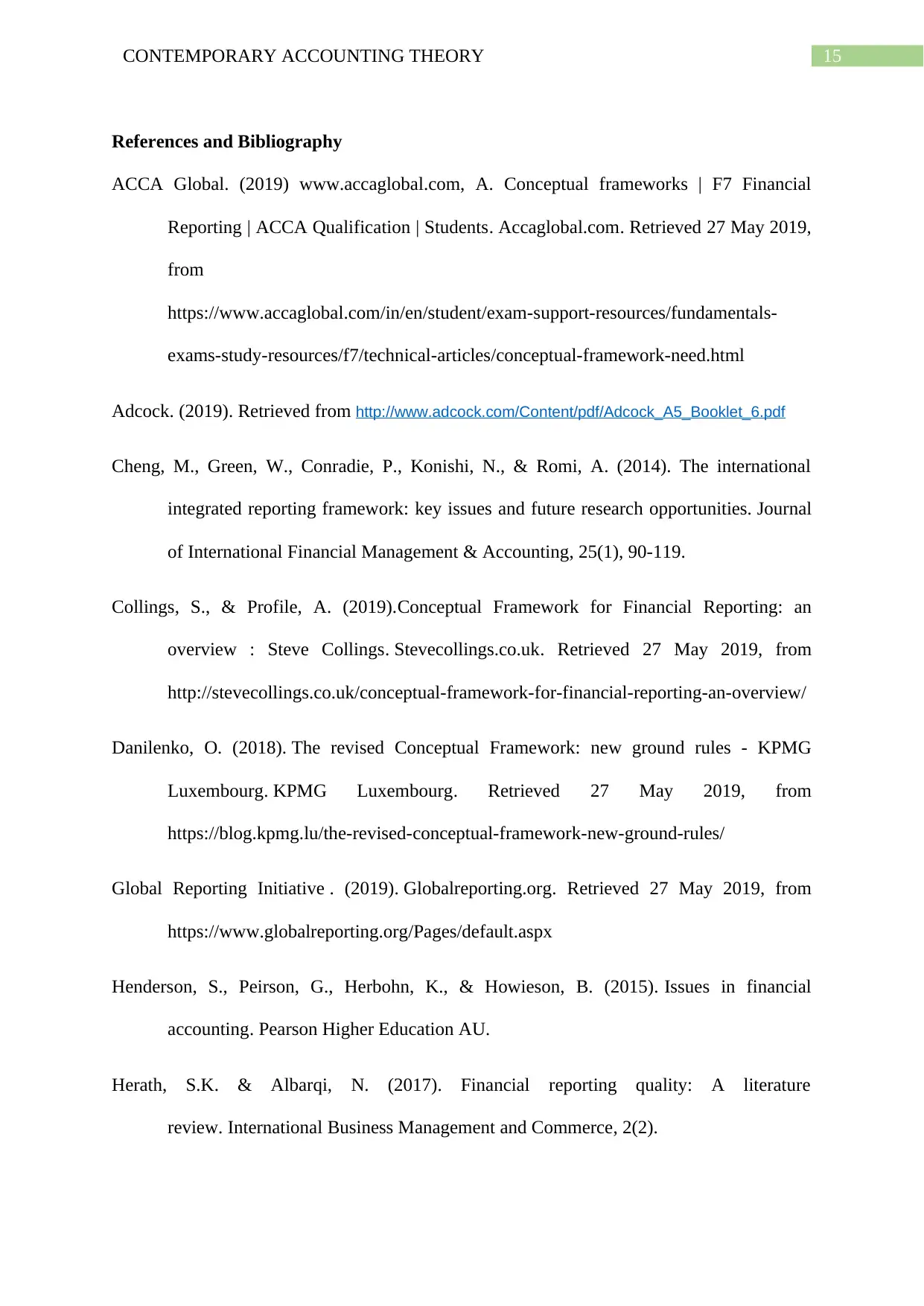
15CONTEMPORARY ACCOUNTING THEORY
References and Bibliography
ACCA Global. (2019) www.accaglobal.com, A. Conceptual frameworks | F7 Financial
Reporting | ACCA Qualification | Students. Accaglobal.com. Retrieved 27 May 2019,
from
https://www.accaglobal.com/in/en/student/exam-support-resources/fundamentals-
exams-study-resources/f7/technical-articles/conceptual-framework-need.html
Adcock. (2019). Retrieved from http://www.adcock.com/Content/pdf/Adcock_A5_Booklet_6.pdf
Cheng, M., Green, W., Conradie, P., Konishi, N., & Romi, A. (2014). The international
integrated reporting framework: key issues and future research opportunities. Journal
of International Financial Management & Accounting, 25(1), 90-119.
Collings, S., & Profile, A. (2019).Conceptual Framework for Financial Reporting: an
overview : Steve Collings. Stevecollings.co.uk. Retrieved 27 May 2019, from
http://stevecollings.co.uk/conceptual-framework-for-financial-reporting-an-overview/
Danilenko, O. (2018). The revised Conceptual Framework: new ground rules - KPMG
Luxembourg. KPMG Luxembourg. Retrieved 27 May 2019, from
https://blog.kpmg.lu/the-revised-conceptual-framework-new-ground-rules/
Global Reporting Initiative . (2019). Globalreporting.org. Retrieved 27 May 2019, from
https://www.globalreporting.org/Pages/default.aspx
Henderson, S., Peirson, G., Herbohn, K., & Howieson, B. (2015). Issues in financial
accounting. Pearson Higher Education AU.
Herath, S.K. & Albarqi, N. (2017). Financial reporting quality: A literature
review. International Business Management and Commerce, 2(2).
References and Bibliography
ACCA Global. (2019) www.accaglobal.com, A. Conceptual frameworks | F7 Financial
Reporting | ACCA Qualification | Students. Accaglobal.com. Retrieved 27 May 2019,
from
https://www.accaglobal.com/in/en/student/exam-support-resources/fundamentals-
exams-study-resources/f7/technical-articles/conceptual-framework-need.html
Adcock. (2019). Retrieved from http://www.adcock.com/Content/pdf/Adcock_A5_Booklet_6.pdf
Cheng, M., Green, W., Conradie, P., Konishi, N., & Romi, A. (2014). The international
integrated reporting framework: key issues and future research opportunities. Journal
of International Financial Management & Accounting, 25(1), 90-119.
Collings, S., & Profile, A. (2019).Conceptual Framework for Financial Reporting: an
overview : Steve Collings. Stevecollings.co.uk. Retrieved 27 May 2019, from
http://stevecollings.co.uk/conceptual-framework-for-financial-reporting-an-overview/
Danilenko, O. (2018). The revised Conceptual Framework: new ground rules - KPMG
Luxembourg. KPMG Luxembourg. Retrieved 27 May 2019, from
https://blog.kpmg.lu/the-revised-conceptual-framework-new-ground-rules/
Global Reporting Initiative . (2019). Globalreporting.org. Retrieved 27 May 2019, from
https://www.globalreporting.org/Pages/default.aspx
Henderson, S., Peirson, G., Herbohn, K., & Howieson, B. (2015). Issues in financial
accounting. Pearson Higher Education AU.
Herath, S.K. & Albarqi, N. (2017). Financial reporting quality: A literature
review. International Business Management and Commerce, 2(2).
Secure Best Marks with AI Grader
Need help grading? Try our AI Grader for instant feedback on your assignments.
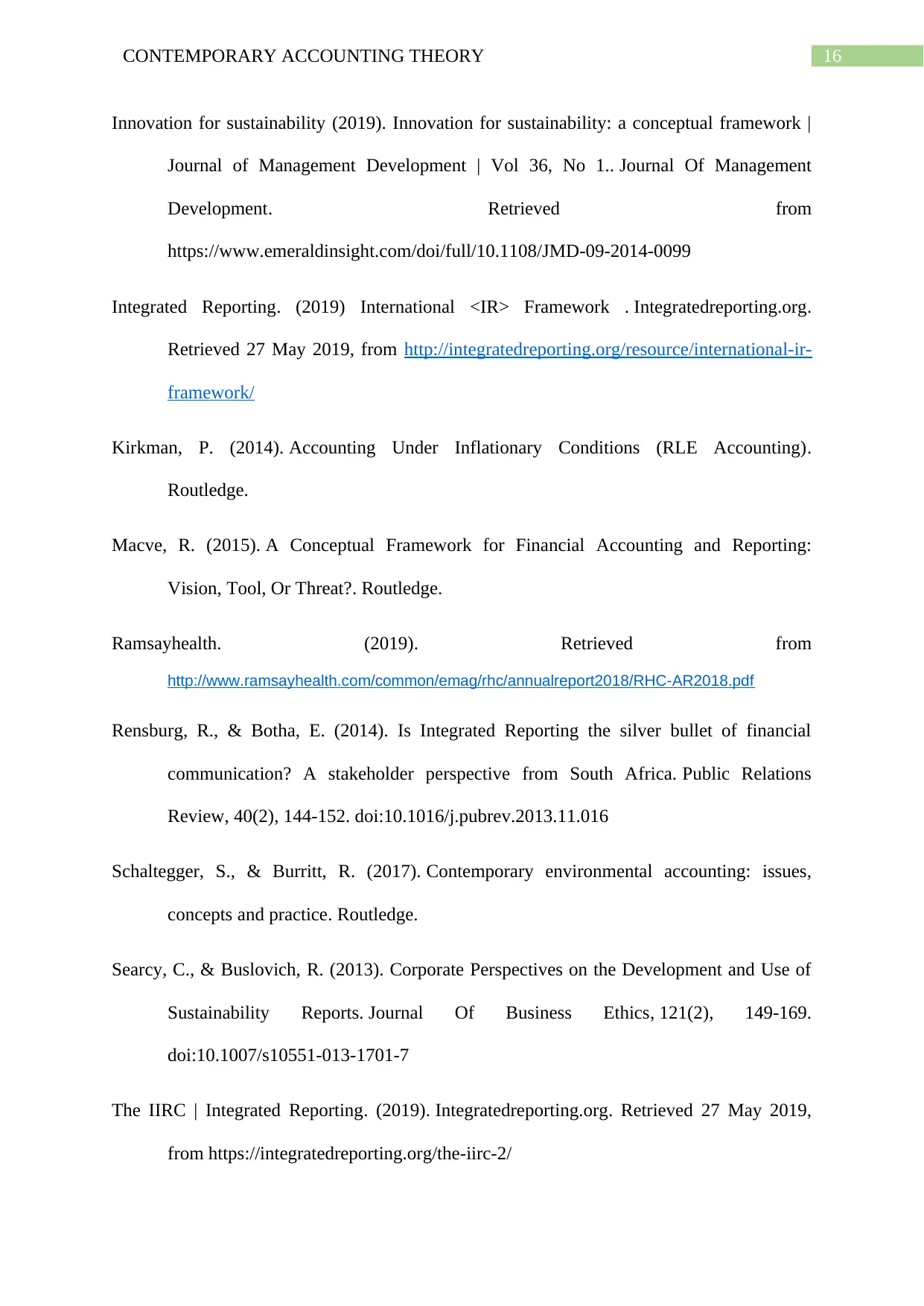
16CONTEMPORARY ACCOUNTING THEORY
Innovation for sustainability (2019). Innovation for sustainability: a conceptual framework |
Journal of Management Development | Vol 36, No 1.. Journal Of Management
Development. Retrieved from
https://www.emeraldinsight.com/doi/full/10.1108/JMD-09-2014-0099
Integrated Reporting. (2019) International <IR> Framework . Integratedreporting.org.
Retrieved 27 May 2019, from http://integratedreporting.org/resource/international-ir-
framework/
Kirkman, P. (2014). Accounting Under Inflationary Conditions (RLE Accounting).
Routledge.
Macve, R. (2015). A Conceptual Framework for Financial Accounting and Reporting:
Vision, Tool, Or Threat?. Routledge.
Ramsayhealth. (2019). Retrieved from
http://www.ramsayhealth.com/common/emag/rhc/annualreport2018/RHC-AR2018.pdf
Rensburg, R., & Botha, E. (2014). Is Integrated Reporting the silver bullet of financial
communication? A stakeholder perspective from South Africa. Public Relations
Review, 40(2), 144-152. doi:10.1016/j.pubrev.2013.11.016
Schaltegger, S., & Burritt, R. (2017). Contemporary environmental accounting: issues,
concepts and practice. Routledge.
Searcy, C., & Buslovich, R. (2013). Corporate Perspectives on the Development and Use of
Sustainability Reports. Journal Of Business Ethics, 121(2), 149-169.
doi:10.1007/s10551-013-1701-7
The IIRC | Integrated Reporting. (2019). Integratedreporting.org. Retrieved 27 May 2019,
from https://integratedreporting.org/the-iirc-2/
Innovation for sustainability (2019). Innovation for sustainability: a conceptual framework |
Journal of Management Development | Vol 36, No 1.. Journal Of Management
Development. Retrieved from
https://www.emeraldinsight.com/doi/full/10.1108/JMD-09-2014-0099
Integrated Reporting. (2019) International <IR> Framework . Integratedreporting.org.
Retrieved 27 May 2019, from http://integratedreporting.org/resource/international-ir-
framework/
Kirkman, P. (2014). Accounting Under Inflationary Conditions (RLE Accounting).
Routledge.
Macve, R. (2015). A Conceptual Framework for Financial Accounting and Reporting:
Vision, Tool, Or Threat?. Routledge.
Ramsayhealth. (2019). Retrieved from
http://www.ramsayhealth.com/common/emag/rhc/annualreport2018/RHC-AR2018.pdf
Rensburg, R., & Botha, E. (2014). Is Integrated Reporting the silver bullet of financial
communication? A stakeholder perspective from South Africa. Public Relations
Review, 40(2), 144-152. doi:10.1016/j.pubrev.2013.11.016
Schaltegger, S., & Burritt, R. (2017). Contemporary environmental accounting: issues,
concepts and practice. Routledge.
Searcy, C., & Buslovich, R. (2013). Corporate Perspectives on the Development and Use of
Sustainability Reports. Journal Of Business Ethics, 121(2), 149-169.
doi:10.1007/s10551-013-1701-7
The IIRC | Integrated Reporting. (2019). Integratedreporting.org. Retrieved 27 May 2019,
from https://integratedreporting.org/the-iirc-2/
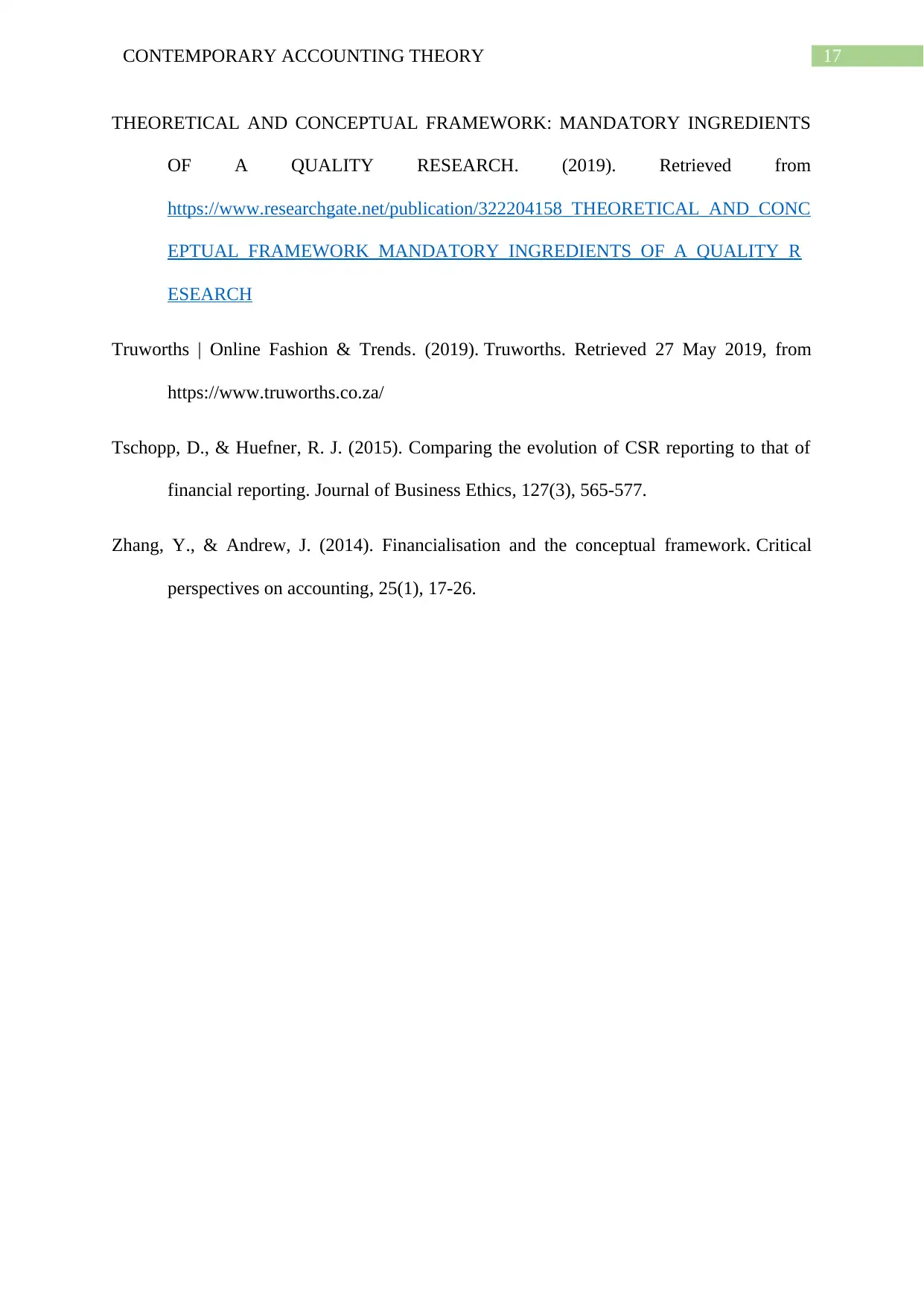
17CONTEMPORARY ACCOUNTING THEORY
THEORETICAL AND CONCEPTUAL FRAMEWORK: MANDATORY INGREDIENTS
OF A QUALITY RESEARCH. (2019). Retrieved from
https://www.researchgate.net/publication/322204158_THEORETICAL_AND_CONC
EPTUAL_FRAMEWORK_MANDATORY_INGREDIENTS_OF_A_QUALITY_R
ESEARCH
Truworths | Online Fashion & Trends. (2019). Truworths. Retrieved 27 May 2019, from
https://www.truworths.co.za/
Tschopp, D., & Huefner, R. J. (2015). Comparing the evolution of CSR reporting to that of
financial reporting. Journal of Business Ethics, 127(3), 565-577.
Zhang, Y., & Andrew, J. (2014). Financialisation and the conceptual framework. Critical
perspectives on accounting, 25(1), 17-26.
THEORETICAL AND CONCEPTUAL FRAMEWORK: MANDATORY INGREDIENTS
OF A QUALITY RESEARCH. (2019). Retrieved from
https://www.researchgate.net/publication/322204158_THEORETICAL_AND_CONC
EPTUAL_FRAMEWORK_MANDATORY_INGREDIENTS_OF_A_QUALITY_R
ESEARCH
Truworths | Online Fashion & Trends. (2019). Truworths. Retrieved 27 May 2019, from
https://www.truworths.co.za/
Tschopp, D., & Huefner, R. J. (2015). Comparing the evolution of CSR reporting to that of
financial reporting. Journal of Business Ethics, 127(3), 565-577.
Zhang, Y., & Andrew, J. (2014). Financialisation and the conceptual framework. Critical
perspectives on accounting, 25(1), 17-26.
1 out of 18
Related Documents
Your All-in-One AI-Powered Toolkit for Academic Success.
+13062052269
info@desklib.com
Available 24*7 on WhatsApp / Email
![[object Object]](/_next/static/media/star-bottom.7253800d.svg)
Unlock your academic potential
© 2024 | Zucol Services PVT LTD | All rights reserved.





